In May of 2007, my cousin Bill and I caught the ferry from Liberty State Park in Jersey City (New Jersey) for a visit to both Ellis Island and Liberty Island.

The islands: In the early 1600's, this area of Upper New York Bay (aka New York Harbor) was the Hudson River estuary. Large tidal flats filled with oyster beds lined the west side. Three islands were not completely submerged at high tide and were called the Oyster Islands by European settlers.
Isaac Bedloe owned Great Oyster Island (Liberty) from 1667 to 1732, then it went to some New York merchants for a while, and in 1800, the federal government decided to build a defensive fort there. The 11-point star-shaped fortification of Fort Wood was completed in 1811.
Little Oyster Island (Ellis) was known as Dyre's Island, then Bucking Island, then Gibbet Island after some pirates were hanged from a tree in the 1760's. A gibbet is any instrument of public execution (guillotine, executioner's block, impalement stake, gallows, etc). Often the dead or dying body was left on public display. At some point after that, it was acquired by a merchant named Samuel Ellis. The State of New York leased the island in 1794 and started to fortify it. The federal government then took ownership in 1808 and built the arsenal of Fort Gibson.
In the 1900's, landfilling (primarily by railroad companies) engulfed the third island and brought the shoreline much closer.

The ferry heads out.


A view of Ellis Island (foreground) with Libery Island in the distance
In the 35 years before Ellis Island opened as an immigrant inspection station, the state of New York had to handle the job. After they had processed over 8 million people, the federal government assumed control in 1890. The size of Ellis Island was doubled, and in 1892, three large ships carrying the first 700 immigrants landed. Almost 450,000 immigrants were processed during the first year, with an average of one million per year from 1905 - 1914. During peak times, immigration officials reviewed up to 5,000 immigrants per day, with an all-time high of 11,747 one day in April, 1907.
The Immigration Act of 1924 allowed processing at overseas embassies and greatly restricted immigration. The only immigrants to pass through would be those who had problems with their paperwork or war refugees. By the time the station closed in 1954, 12 million immigrants had passed through its doors.

Passing the main building
The main building, built of red brick with limestone trim, was designed in the French Renaissance Revival style. It opened in 1900. Even though it was so large that the dining room could seat 1,000 people, it was woefully inadequate in the years approaching World War I. Immigrants had to sleep on bunk beds in a huge hall with blankets that weren't warm enough.

Pulling up to the dock

Disembarking


Due to a recent "incident," some areas were blocked off and a K9 unit was brought in.




The Great Hall

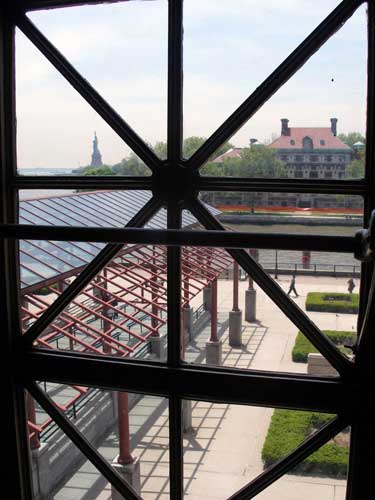
Hallways ... and views

A courtroom
Generally, immigrants who were approved spent two to five hours at the station. They were asked a series of questions including name, occupation and how much money they carried (preferably at least 18 to 25 dollars... about $600 in today's terms). Those with visible health problems were sent home. Some were quarantined for long periods of time. More than 3,000 died while being held in the hospital facilities. Wealthy immigrants got automatic entry. About 2% of those who did not travel first or second class were sent back due to a chronic contagious disease, a criminal background or insanity. After 1924, Ellis Island became primarily a detention and deportation processing station

Row 1 (left to right) - Italian domestic (destination Lowell, MA), Austrian laborer (deported), Russian girl (Gackle, ND), Dutchman (unknown)
Row 2 - Serbian farm laborer (deported), Hungarian servant (Trenton, NJ), Swedish farmer from South Dakota (returning from first visit to homeland), Russian wife (Gackle, ND)

Row 1 - Russian widow (destination Lancaster, PA), German painter (New York City), Irish servant (NYC), Russian student (NYC)
Row 2 - Shepard (destination Wyoming), Russian servant (Salem, MA), Italian laborer (St. Louis, MO), Romanian domestic (unknown)
In 1897, a fire burned everything down. No one was killed, but about 1.5 million immigration records dating back to 1855 were destroyed.
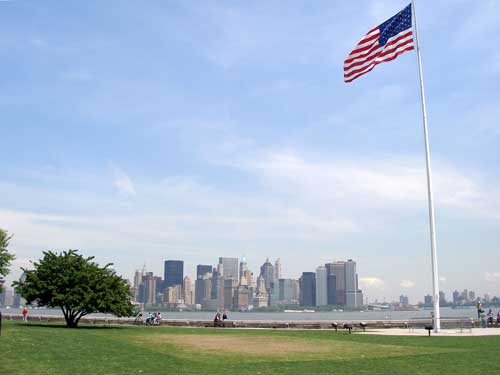
The view outside
We hopped back on the ferry and continued on...

Leaving Ellis Island...

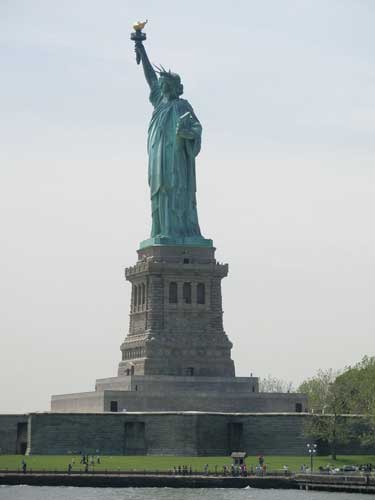
... and approaching Liberty Island

The pointed base is actually the remains of Fort Wood.

In 1865, Edouard de Laboulaye proposed that a monument be built as a gift from France to honor the work of the late President Abraham Lincoln. He also hoped that by calling attention to the recent achievements of the US, French citizens would be inspired to create their own democracy (France was still split between those who wanted a monarchy and those who wanted freedom and justice).
The concept of "liberty"still carried strong overtones of violence and revolution, so it was important that the image would be seen as a peaceful symbol of lighting the way. No weapons, no armor, no fallen soldiers, etc. In early American history, the female figures of Columbia (the original name for the Thirteen Colonies) and Liberty (after Libertas, the Roman goddess of freedom which featured prominently on most American coins of the time) seemed ideal. And so, "Liberty Enlightening the World" was born.
In order to turn his idea into a reality, Laboulaye teamed up with Auguste Bartholdi, a French sculptor. When they visited the States and sailed into New York Harbor, they realized Bedloe's Island would be perfect. Since the US government already owned it, the agreement was quickly made. By that time, the fort was no longer being used and its foundation walls could serve as a base.
The construction of the statue was done in France. Bartholdi sought help from Alexandre Gustave Eiffel (1832 - 1923, the engineer who had built the Eiffel Tower) because of his experience with wind stresses. After it was completed, it was dismantled and shipped to the US, arriving in New York Harbor in June, 1885. Unfortunately the pedestal was not yet completed so it was stored for eleven months in crates. The statue was then reassembled in four months. The name Liberty Island was made official in 1956.
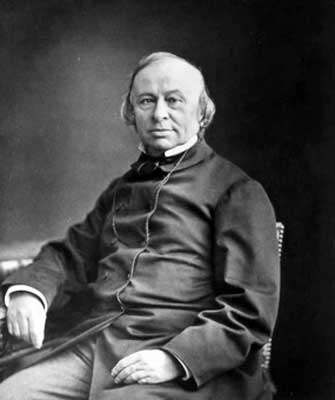
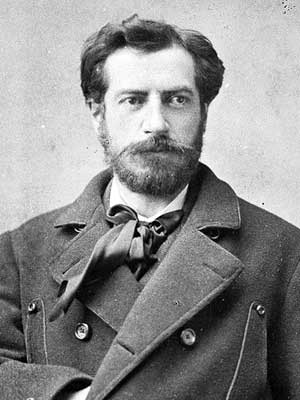
Edouard Rene Lefebvre de Laboulaye (1811 - 1883) and Frederic Auguste Bartholdi (1834 - 1904)

Before the statue was fully finished, the head and the torch-bearing arm were exhibited at expositions in both the States and France.
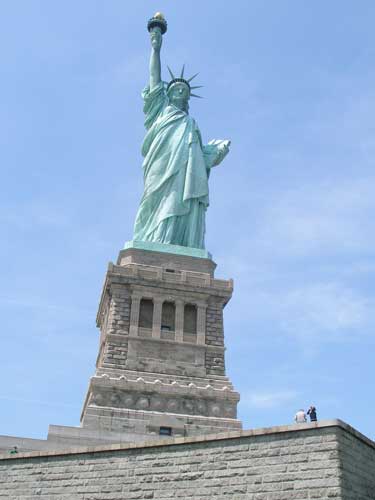
The statue itself is 151 feet tall (and 305 feet with the pedestal and foundation).

The statue is clad in copper, which turns green as it oxidizes. 200,000 pounds of copper went into its creation.
The statue's symbols of freedom:
- the seven rays on her crown represent the seven seas, the seven continents and even the gleaming sun
- her torch and flame symbolize truth and justice enlightening the world
- on her tablet is the date of the American Declaration of Independence, July 4, 1776
- broken shackles at her feet signify escape from tyranny

Original designs included a pileus (a cap worn by emancipated slaves in ancient Rome), but this was too similar to Marianne, France's symbol of liberty. A helmet was also not an option for a peaceful statue. Finally a diadem (a type of ornamental headband worn by royalty) was agreed upon.

The flame of the torch is coated in gold.

July 4, 1776, written in Roman numerals

Remnants of a chain peek from beneath her flowing robe.
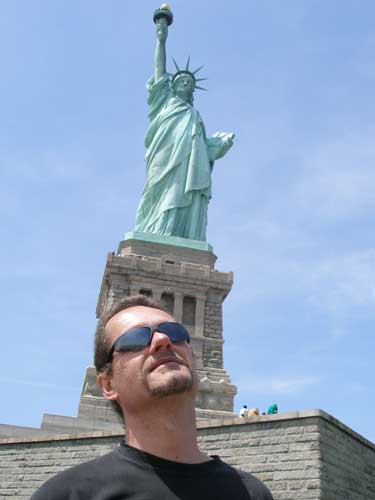
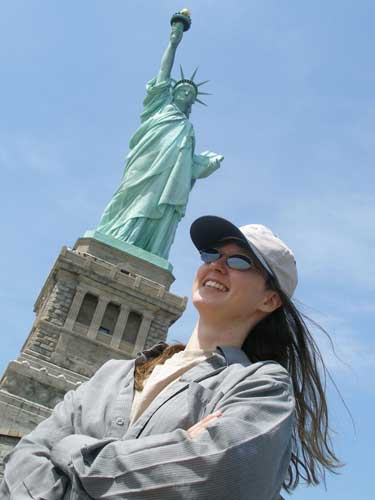
Hangin' with the lady!

Emma Lazarus (1849 - 1887) wrote a sonnet in 1883 as an attempt to raise funds for the pedestal's completion.
It had been agreed that while the French would foot the bill for the statue, the Americans had to provide the pedestal. Fundraising was difficult, but eventually after 5 months of daily calls asking for donations, enough money was raised from 120,000 donors... with most of them giving less than one dollar.

The rarely-seen side. Her lifted right foot symbolizes that she is always on the move.
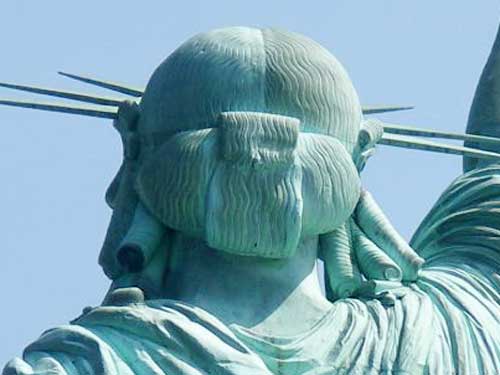
Who knew she had such cute curls!! From here, it's easier to see she wears an ornate headband as opposed to a full crown.
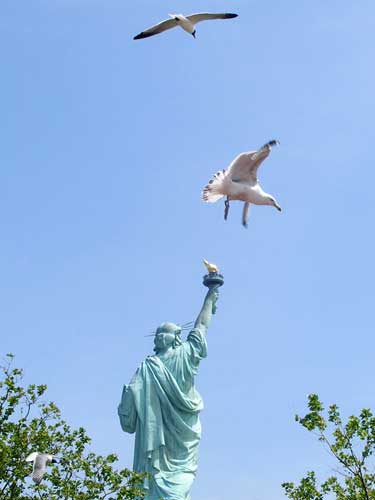
Everyone believes the Statue of Liberty is in New York, but technically it sits on the New Jersey side of the state line. In 1987, the mayor of Jersey City even attempted to sue New York City over it. While technically it has been owned by the federal government since 1801, other rights are split between the two states. The land above water belongs to New York; the submerged land belongs to New Jersey; New York has control of the island; but the taxes go to New Jersey. The National Park Service has run operations since 1933.

The New York (Manhattan) skyline from Liberty Island



A view of Ellis Island
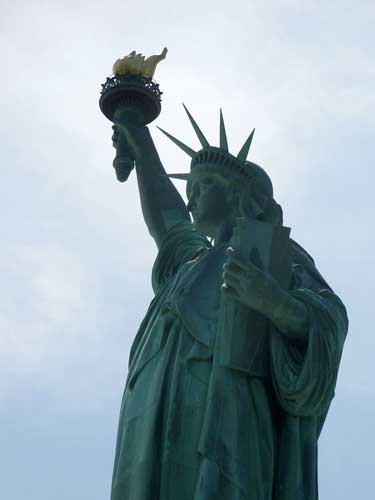
Liberty Enlightening the World
return

